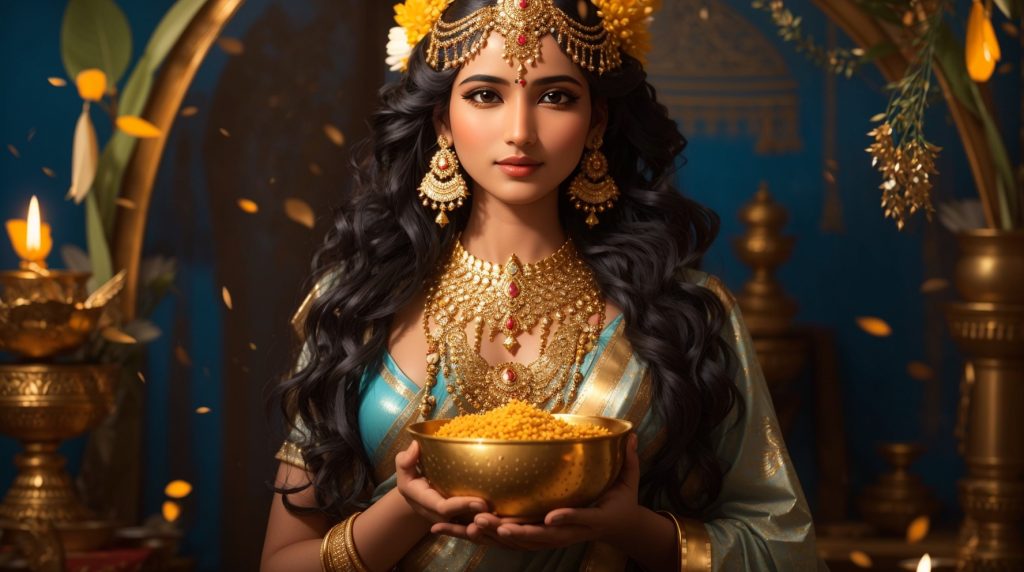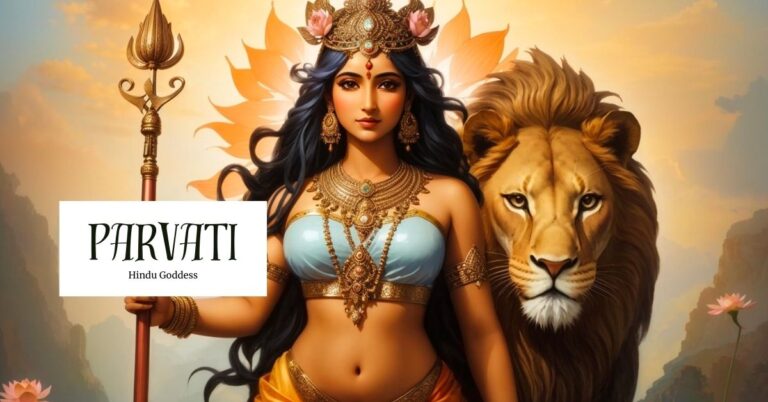Annapurna: The Goddess of Food and Nourishment
The pantheon of Hindu mythology is a rich tapestry of deities that hold significant positions, each representing different aspects of life and nature. Among these divine beings is Annapurna, the revered goddess of food and nourishment. Her benevolent presence ensures the sustenance and fulfillment of human needs, and her story and significance have been woven into the cultural fabric of India, particularly in the holy city of Kashi.
Overview of Annapurna
Annapurna, also referred to as Annapoorna, is a highly esteemed deity in the Hindu religion. In particular, she is revered as the goddess of food and nourishment. The name “Annapurna” is derived from the Sanskrit language, with “Anna” meaning food and “Purna” signifying completeness. As such, she embodies the concept of being the provider of sustenance and abundance in the lives of her devotees.
Annapurna’s depictions may vary, but it is customary to see her holding a vessel filled with rice grains in one hand and a spoon in the other, symbolizing her pivotal role as the bestower of food and nourishment (“Annapurna (Goddess)”).
Source: Neopathy
Titles
- Goddess of Earth
- Goddess of Atom
- Donor of Food
Abilities
Annapurna’s significance within the Hindu pantheon is derived from her multifaceted abilities, which make her a vital deity. She is believed to possess the power to nourish and sustain all living beings, thereby decisively eradicating hunger and deprivation.
Through her benevolence, Annapurna blesses her devotees with abundance and prosperity, granting them the ability to thrive and prosper. It is widely believed that her compassionate nature extends beyond physical nourishment and encompasses spiritual food.
Those who seek her blessings are enriched in their material and spiritual lives, experiencing the profound impact of her grace and generosity, which are believed to be inexhaustible and limitless (“Story of Devi Annapurna – the Hindu Goddess of Food – the Goddess of City Kashi”).
Characteristics
The physical appearance of Annapurna is often depicted as that of a radiant goddess adorned with divine attire and exquisite jewels. Her gentle countenance and motherly aura exude an undeniable warmth and compassion, endearing her to countless devotees. The depth of her nurturing nature is reflected in her eyes, imparting comfort and reassurance to all who behold her.
Annapurna is frequently portrayed as the embodiment of nourishment, holding a golden vessel brimming with rice grains in one hand while grasping a spoon in the other. These iconic symbols represent her pivotal role as the provider of food and sustenance, showcasing her unwavering commitment to ensuring the well-being of all. In some traditions, she’s known as an aspect of the mother goddess Devi.
Her divine grace and benevolence have inspired countless acts of charity and compassion as devotees seek to emulate her example and spread her message of love and generosity to all corners of the world (“Goddess Annapurna – Hindu God of Food – Story, Photo, Mantra, Temples”).
Source: AstroVedPedia
Traits
Annapurna possesses a significance that extends beyond her physical attributes. In addition to her beauty, Annapurna is venerated for her unwavering compassion, kindness, and generosity. She ensures no one goes hungry under her watchful gaze, and her benevolence transcends boundaries to encompass all living beings.
Embracing the role of a nurturing and loving mother, Annapurna tirelessly nurtures and supports her children, embodying selflessness and dedication in her quest to provide sustenance.
These ideal characteristics of a divine goddess endear Annapurna to her devotees and inspire them to embrace compassion and generosity in their own lives. Annapurna symbolizes maternal love and selflessness, and her divine nature is an enduring example for all to follow (“Explore Everything about Annapurna Devi (the Goddess Annapurna)”).
Symbols
Among the prominent symbols, Annapurna is associated with is the golden bowl she holds, brimming with rice. The golden bowl symbolizes the abundance of food and nourishment she bestows upon her devotees.
The spoon she wields represents her active role in distributing food to those in need, emphasizing her position as the provider of sustenance. Furthermore, the overflowing rice grains from the bowl serve as a powerful visual representation of the endless blessings and abundance that Annapurna offers to her devotees.
These symbols are constant reminders of Annapurna’s divine presence and her unwavering commitment to nourishing all who seek her blessings. Through these symbols, her devotees can connect with her on a deeper spiritual level, recognizing her as the embodiment of all that is good and nourishing in this world (“Annapurna (Goddess)”).
Source: Pinterest.com
Festivals and Rituals
Annually, devotees celebrate Annapurna, the goddess of nourishment, through various festivals and rituals dedicated to her worship. One such festival is the Annapurna Jayanti, which falls on the eighth day of the waxing moon in Margashirsha (November-December) (“Annapurna Jayanti 2023: Story, Worship and Significance of Annapurna Devi”). During this auspicious occasion, devotees offer fervent prayers and perform special rituals to honor Annapurna and seek her blessings for abundance and prosperity.
Another significant occasion is the Annakut festival, also known as Govardhan Puja, celebrated on the fourth day of Diwali. Devotees prepare a grand feast consisting of various vegetarian dishes offered to Annapurna and then distributed as prasad (blessed food) to the community. This ritual is a way of expressing gratitude for the bountiful harvest and seeking blessings for future abundance.
Both festivals hold great significance in the Hindu culture, and devotees partake in them with utmost devotion and reverence. Through their offerings and prayers, they seek to please Annapurna and express gratitude for her blessings. These festivals remind us of the importance of sustenance and abundance in our lives and the need to honor and respect the divine source of all nourishment.
Source: WordPress
Legends associated with Annapurna
In Hindu legends, the Goddess Annapurna holds a place of significance as the divine bestower of food and nourishment. Her benevolent and nurturing nature has earned her widespread reverence, as she is celebrated for her pivotal role in providing sustenance to all living beings. Throughout the ages, many legends have emerged, each recounting the origin and influences of this revered deity.
Origin story
The origin tale of Goddess Annapurna is steeped in intricate symbolism and profound spiritual significance. According to a widely-circulated legend, her emergence is intricately linked to the cosmic dance of Lord Shiva, commonly known as the “Tandava.”
As the story goes, during this eternal celestial dance, Shiva’s beloved consort, Parvati, whimsically covered his eyes, enveloping the universe in darkness. To restore cosmic balance and illuminate the world, Lord Shiva unlocked his third eye, from which the divine radiance of Goddess Annapurna manifested.
In her ethereal form, she personified the goddess of food and became the embodiment of nourishment for all living beings. This legend highlights the vital role played by Annapurna in sustaining life through the gift of food and underscores her significance as a compassionate and nurturing deity (“Annapurna (Goddess)”).
Her divine presence remains deeply revered to this day, and her story serves as a poignant reminder of the critical importance of nourishment and abundance in the cyclical nature of existence.
Source: Tumblr
Lord Shiva and the Grand Banquet
According to a legend, Goddess Annapurna, known for her divine culinary skills and benevolent nature, once satisfied Lord Shiva’s desire for a sumptuous meal.
The story goes that Lord Shiva expressed his ardent desire to experience the joys of a grand feast. Intrigued by his wish, the goddess materialized a magnificent banquet with abundant delectable dishes in golden bowls.
This great feast was laid out in the sacred city of Kashi (Varanasi), the very abode of the goddess herself. Disguised as a wandering ascetic, Lord Shiva arrived at Annapurna’s doorstep seeking alms. Recognizing him, the goddess lovingly served him the divine meal, revealing her true identity.
Lord Shiva experienced profound satisfaction and contentment as he partook in the food and acknowledged the goddess’s boundless grace and culinary artistry (“Story of Devi Annapurna – the Hindu Goddess of Food – the Goddess of City Kashi”).
This legend highlights Annapurna’s role as the food provider and reflects her caring and nurturing nature, nurturing her devotees’ physical and spiritual well-being through sustenance. Indeed, the story of Annapurna and Lord Shiva is a testament to the goddess’s generosity, culinary prowess, and ability to foster spiritual well-being by providing food.
Source: Detechter
Lord Krishna and the Boon
According to legend, the Goddess Annapurna had a divine interaction with Lord Krishna, one of Hindu mythology’s most prominent deities.
During Lord Krishna’s visit to the holy city of Kashi, he expressed his deep desire to partake in a meal prepared by the illustrious Annapurna herself. Moved by his request, the goddess served Lord Krishna with an array of dishes crafted with her divine touch.
As Lord Krishna relished the meal, he was overwhelmed by the profound grace and blessings bestowed upon him by Annapurna. In gratitude and recognition for the goddess’s benevolence, Lord Krishna granted Annapurna a boon, declaring she would forever be revered and worshiped as the divine provider of nourishment and abundance.
This sacred bond between Lord Krishna and Goddess Annapurna solidified her place as a cherished deity, revered by devotees for her role in bestowing sustenance and prosperity upon all beings (“Story of Devi Annapurna – the Hindu Goddess of Food – the Goddess of City Kashi”).
Source: Wikipedia
Influences of other religions/cultures on Annapurna
Within Hinduism, Annapurna is often depicted as a benevolent provider of sustenance to all living beings. However, her influence extends beyond the confines of Hindu beliefs, subtly shaping broader conceptions of nourishment, sustenance, and goddess worship.
In ancient India, Buddhism and Jainism emerged as spiritual counterparts to Hinduism, sharing a similar cultural landscape. These traditions advocate for compassion, non-violence, and conscientious care for all sentient beings.
While Annapurna’s name may not be invoked within their pantheons, the virtues of empathy, benevolence, and mindful consumption championed by Buddhism and Jainism may have contributed to a heightened societal awareness regarding equitable nourishment and the equitable distribution of sustenance through Annapurna.

Source: Leonardo.ai
Modern appearances
In the contemporary era, the veneration of Goddess Annapurna remains a vibrant and profoundly ingrained aspect of the hearts of her devotees. People from all walks of life seek her divine blessings for prosperity, abundance, and nourishment in their daily lives.
Annapurna’s presence extends beyond the temple walls. It permeates into countless homes, where families pay homage to her before partaking in meals, recognizing her pivotal role as the provider of food and sustenance.
In households across India, it is customary to offer prayers and express gratitude to Annapurna before meals, seeking her blessings to ensure that their sustenance is imbued with her grace.
This act of reverence reflects the devotees’ acknowledgment of the vital importance of food and the benevolence of the goddess in providing nourishment for their physical and spiritual well-being. Such rituals reinforce the profound spiritual connection between the devotees and their deity, fostering a sense of deep-seated gratitude and reverence towards Annapurna.
Source: Exotic India Art
Final thoughts
Within Hindu mythology, the divine figure of Goddess Annapurna reigns supreme as the patron of sustenance and nourishment. Her enduring legend, which stretches back to ancient times, is steeped in tales of her origin and her interactions with other divine beings, which reinforce her pivotal role as the provider of sustenance to the entire universe. The worship of Annapurna, which remains deeply embedded in Hindu culture to this day, continues to serve as a reminder of the vital importance of nourishment, gratitude, and the divine blessings bestowed upon humanity through her benevolent presence.
Annapurna’s legacy transcends generations, for she is the goddess of plenty who inspires devotees to embody her virtues of selflessness and compassion. Her divine essence fosters a sense of interconnectedness among individuals and motivates them to care for one another, ensuring the well-being of all beings. The enduring worship of Annapurna exemplifies the timeless relevance of her significance, reinforcing the ever-present need to acknowledge the sanctity of food and the divine grace flowing from her maternal embrace (“Explore Everything about Annapurna Devi (the Goddess Annapurna)”).
References
“Annapurna (Goddess).” Wikipedia, 6 Apr. 2023, en.wikipedia.org/wiki/Annapurna_(goddess). Accessed 27 July 2023.
“Annapurna Jayanti 2023: Story, Worship and Significance of Annapurna Devi.” GaneshaSpeaks, www.ganeshaspeaks.com/predictions/festivals/annapurna-jayanti/. Accessed 27 July 2023.
“Explore Everything about Annapurna Devi (the Goddess Annapurna).” Www.rudraksha-Ratna.com, www.rudraksha-ratna.com/articles/goddess-annapurna.
“Goddess Annapurna – Hindu God of Food – Story, Photo, Mantra, Temples.” TemplePurohit – Your Spiritual Destination | Bhakti, Shraddha Aur Ashirwad, 24 Sept. 2016, www.templepurohit.com/goddess-annapurna-the-hindu-god-of-food/.
“Story of Devi Annapurna – the Hindu Goddess of Food – the Goddess of City Kashi.” Indian Astrology, 25 Feb. 2020, indianastrology.co.in/7117-story-of-devi-annapurna-the-hindu-goddess-of-food-the-goddess-of-city-kashi/. Accessed 27 July 2023.






